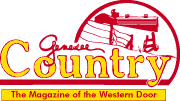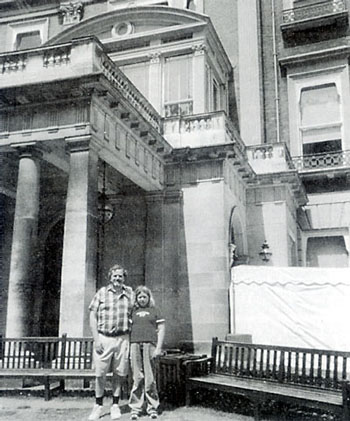
Genesee Country Magazine
Greatest Hits
Search Our Website!
 |
Genesee Country Magazine | Search Our Website! |
Related
Links: | GC Magazine Home | GC Greatest Hits | Clarion Publications | WNY Travel Guide |
The Other Hartford HouseDigging out the British roots of a very American home
|
 |
In search of the real Hartford House: The author and daughter Corrina Strong at Hertford House on Manchester Square in London in 1999. The home of the famed Wallace Collection is not the house on which the Geneseo home was modelled. |
Americans are not alone in being mystified by British aristocratic titles - many
British people are equally bewildered.
Although some such titles are still granted today, most date back into antiquity, to a time when monarchs wished to confer favor upon worthy individuals, usually soldiers or political figures. With the title came royal patronage, ranging from the granting of vast estates to a job in the royal household. Titles were also hereditary, passing from one generation to the next as a means of perpetuating both family honor and loyalty to the sovereign.
An aristocrat's title indicates his rank in what is known as the peerage. The title of duke is the highest rank, followed in descending order by marquis, earl, viscount and baron. All but dukes will typically be addressed “My Lord”. Hence the Marquis of Hertford will also have been known as Lord Hertford.
Baronet is also an hereditary title, ranking below that of baron, and considered not to be part of the peerage. One of the most recently created baronets is Denis Thatcher, husband of the former Prime Minister. This means he is now addressed as Sir Denis Thatcher, Bart.
Wives of peers have titles too. Dukes' wives are duchesses; the wife of a marquis is a marchioness. The title of earl is equivalent to that of count in many other countries, which explains why an earl's wife is called a countess. Then there are viscountesses and baronesses. The wife of a baronet is referred to simply as Lady.
Historically, all members of the peerage were allowed to sit in the House of Lords, the upper chamber of the British parliament. This placed them right at the heart of the country's government. Over time, though, the power of the House of Lords has been eroded in favour of the popularly elected House of Commons. This has been achieved, in part, by the appointment of what are known as Life Peers, political appointees who take the title of Lord but who cannot pass that title on to their heirs.
So, if you encounter a lord, you might be meeting either a real aristocrat or just someone given that honor as a political favor. This rather exemplifies the many confusions in the system. Misunderstandings also arise from the use of the title Sir. This can signify either a baronet or someone who has received a knighthood, the latter being a non-hereditary honor bestowed on all sorts of people, including recently Michael Caine and Stephen Redgrave.
Finally, it is important to remember that aristocrats are not royalty. They may be related to royalty through marriage, but they are not in the line of succession to the throne. Just to blur the distinction, however, royal family members are often granted the same titles as non-royal aristocrats. The Duke of York and the Earl of Wessex, for instance, are both sons of the present queen.
Complete
copies of Philip Basham's article on the British origins of Hartford House will
be placed in the Genesee Valley History Collection at Milne Library at SUNY Geneseo
and the Livingston County Historian's Office.
According to WebCounter
you are the
person to answer the Clarion Call
©2008 Clarion Publications, Inc. All
Rights Reserved.
This site designed by Clarion Communications.